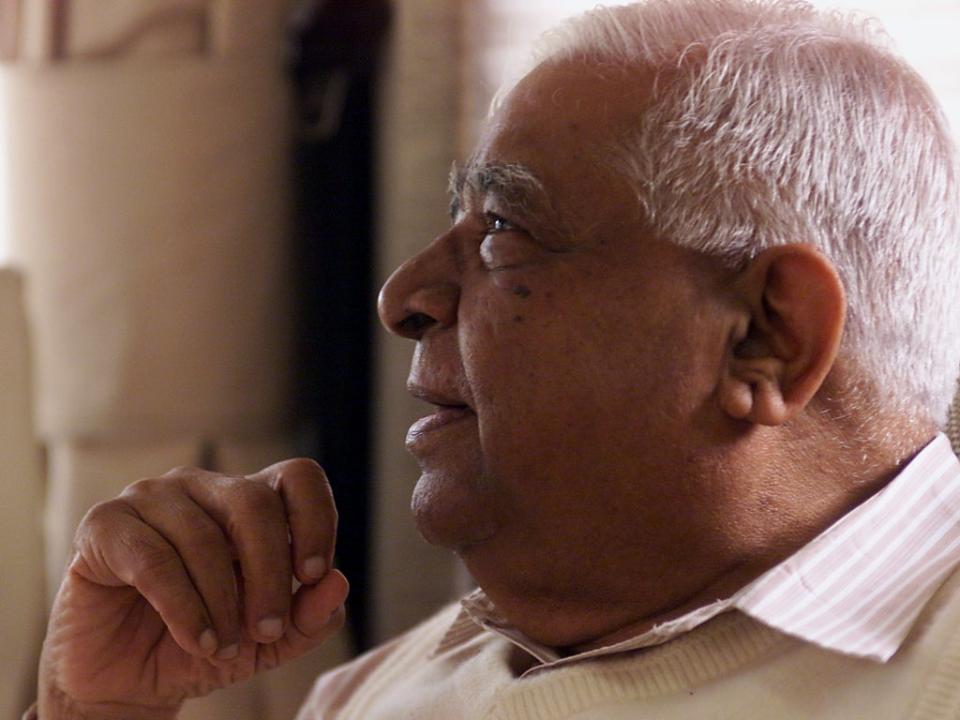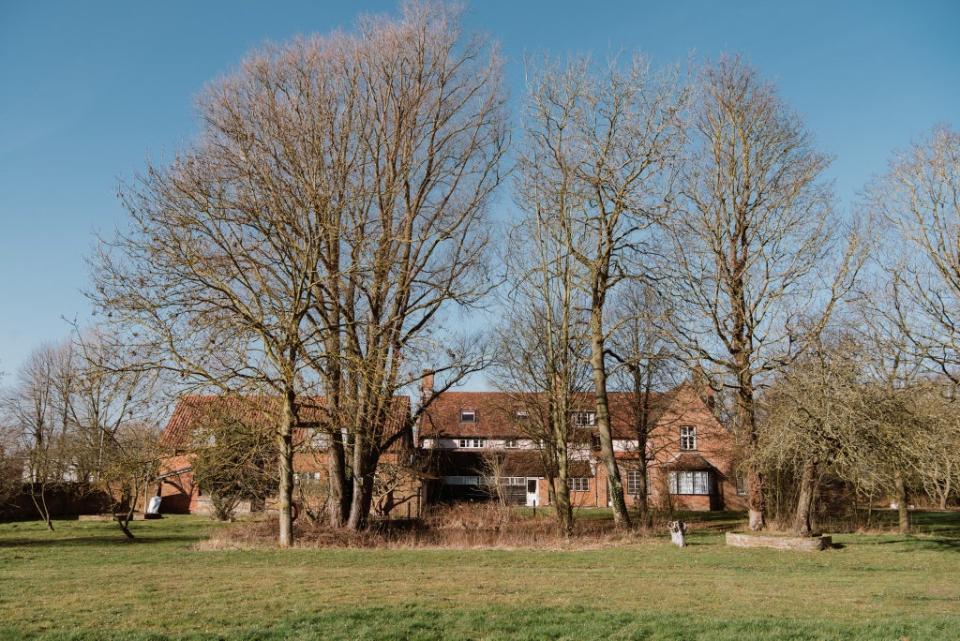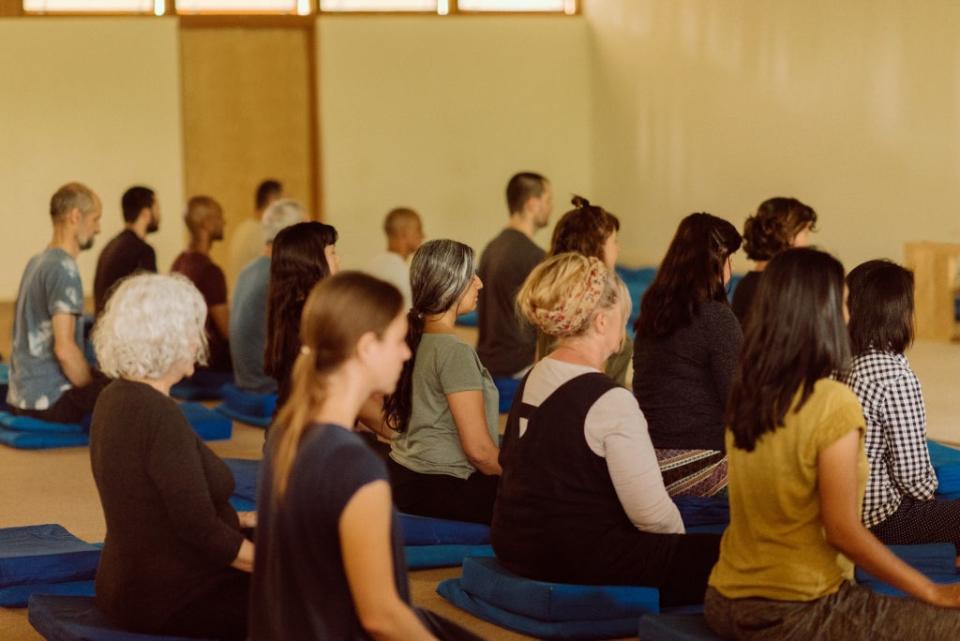Can 10 days of silence and meditation teach you the art of living?

Two men are sitting at a bar. One reveals that his son has started meditating. The other says: “I suppose it’s better than sitting around doing nothing.” This hoary joke speaks to the cynicism about meditation among people who have never tried it. Such doubts are misplaced, as the evidence is clear that meditating is good for you. Long regarded as a valuable practise in Asia, it has lately been repackaged as mindfulness for the over-harried workers of the western world. From Jon Kabat Zinn to Headspace – an app with over two million subscribers – sitting around doing nothing has never been so fashionable.
One of the oldest routes to enlightenment is through Vipassana meditation. According to its promoter, SN Goenka, this is how the Buddha found his way to the top of the spiritual mountain. Goenka’s 10-day retreats are the stuff of legend, and, although he died in 2013, it seems appropriate to speak about him in the present tense, because his fans are determined to keep his spirit alive. Indeed, his voice is one of the only things students hear every day, and at night he provides the only amusement. If there were prizes for public speaking in a Vipassana course, Goenka would win every time, without once bothering to change his shtick.
A stern but charismatic frontman, Goenka is not above teasing his students. On day three, after sitting in the same position for a total of 30 hours, he announces that you are still in “kindergarten Vipassana”. Such jibes are unsettling, and perhaps that is deliberate. Is this a cult? I did not sign up for a 10-day Vipassana course to answer that question. I just wanted to scratch an itch. But the question refuses to go away, and I am not alone in asking it.
There are Vipassana centres all over the world. However, as meditation is so hip just now, it is hard to secure a place on a course. You have to log in a few minutes before applications open and then repeatedly refresh your browser. I tried and failed to sign up for three courses before I was accepted for one at Dhamma Sukhakari in Stowmarket. At that point I was told several times in writing, and again on arrival, that the course is a demanding experience, that it can be dangerous to leave early, and that I must commit myself to stay until the end.
The routine is identical in every centre. To achieve “self-purification by observation”, you get up at 4am. You meditate. You have breakfast. You meditate. You have lunch at 11am. You rest and/or wash for 90 minutes. You meditate. You have two pieces of fruit for supper. You meditate. You watch a 60-minute discourse by Goenka. You meditate. And then, at about 9pm, you go to bed. All this you do in silence. You are not even allowed to gesture to other people. The silence is a merciful release for introverts like me, although extroverts often look for small ways to communicate with other students. Hand signs. Sharing oranges. Stolen glances. All these acts are technically verboten.
Is Vipassana a cult? On the internet, some malcontents claim as much. They reference the strict timetable, the lack of sleep, the blind devotion of some students. I’m not so sure
There are three elements to the Vipassana practise: sila, samadhi and panna. Sila is the moral stuff: refrain from sexual shenanigans, don’t lie, don’t steal and don’t kill, which means no lamb chops on the menu. (Yes, the food is vegetarian. No, it’s not bad.) There are supposed to be five precepts in sila. This is a dramatic understatement. I counted 37 rules. So men and women are completely separated; all stimulants are banned; you hand in your mobile phone on day one; you forswear all communication; and you promise not to read or write for the duration of the course. Just for good measure, it is forbidden to touch anyone, and you cannot smoke, wear shorts, do yoga or any physical exercise. You cannot even go for a jog when no one’s looking. In short, Vipassana is nothing like a stag weekend in Amsterdam.
Samadhi is the second element of the practise. It means concentration. And panna is the wisdom you get from all this sitting around. For the first three days – in other words, for the first 30 hours of meditating – you just observe your breathing, with an emphasis on the nostrils and, latterly, the tip of the nose. It is surprisingly difficult. As Goenka says, the human mind is like a wild animal, and it must be tamed. He also points out that you would never give a wild animal any stimulants. After three days of observing quite how unruly my own mind is, I am obliged to concur. Booze is not a good idea.

Eventually, observing your own breathing becomes a bit easier, at which point you are introduced to Vipassana, which means “seeing things as they really are”. Anyone who has used a meditation app will know this practise as a “body scan”, although Goenka does not use that term. If you do it every day of your life, for an hour in the morning and an hour in the evening, the technique “will eradicate suffering”, as a leaflet puts it. (This leaflet is the only thing you’re supposed to read on the course. There are just eight pages in this Vipassana bible.)
The evening discourses are the only form of recreation. These talks are delivered, of course, by Goenka, who was born into a wealthy Hindu business family. In the leaflet, “wealth and prominence gave him no peace. Instead, mental tension triggered debilitating migraines that could be treated only with doses of highly addictive morphine.” In the modern parlance, he was a rich kid who got hooked on the hard stuff, until he found Vipassana. Like any true believer, he wanted to spread the word, but unlike most of us he had the money to do so.
The discourses are not intended as “intellectual entertainment”, to use Goenka’s phrase, but he is a fine communicator, with an endless supply of homely anecdotes, and while the talks were recorded in 1990, most of his stories have aged well. It is hard to reconcile his claim that Vipassana is entirely scientific with the “fact” that consciousness jumps from one host to another at the point of death, though we all have our weak spots. He comes across as a stern but affable grandfather, essentially benign but not afraid to use a metaphorical rod. There are fables galore, the life of the Buddha is presented in bite-size chunks, and there are frequent observations about the negative power of emotions: he tells us, for example, that the first victim of our anger is not the subject of our annoyance but ourselves.

Such nuggets enliven the retreat. They give it shape and value. But wise observations are scant consolation for all that agony. And just when you’re getting used to the endless meditations, Goenka introduces a new concept called adithana, which means “sittings of strong determination”. For these one hour sittings, you are not supposed to move at all. This is a doctrine of pain. I often wonder if my knees will survive the experience. They do, of course, and that is the point. As Goenka says a dozen times, everything is impermanent – in Pali, the ancient language of India, the word is anicca – and now we are learning as much through our bodies. It is not enough to know it intellectually, we must have physical understanding that all things pass, just like the sensations in our body.
The goal of Vipassana is to cultivate the equanimity necessary to endure life’s vicissitudes. It is a noble aspiration, but there is a great deal of agony and discomfort along the way. I laugh once in the first nine days, and soon regret my giddiness. When the man sitting in front of me raises his arms to heaven, as if communing with God, I think he is joking; it seems like a comic performance; but he isn’t messing. Not at all. He is having a breakdown. The following day, he has to leave. And he isn’t the only one who goes before the end. The first of five male students to quit the course is the most athletic and butch young man among us. Incidentally, all but one of the women stay until the end, which may prove that they are more strong minded, or that men never really listen.
The austerity of the Vipassana regime leaves me pining for some of the things that give life its variety and richness. The things I ought to renounce. The things I am loath to live without
After breakfast on day 10, students are allowed to speak to each other. Although this development is telegraphed, the chatter is exhausting, and while it is pleasant to have one’s preconceptions shattered – he’s not a fireman, he’s an actuary! – I soon duck out, returning to my dorm for a nap. But that night, in one of the last windows available for socialising, I have an intense discussion with an Indian psychotherapist. Allergic to small talk, he wants to interrogate the thinking of Hume, Nietzsche and Socrates. “Philosophy builds itself by destruction, and what it destroys is assumptions.” It’s the sort of conversation I’ve been pining for; perhaps I just want to hear intelligent humans talking about something other than meditation.
Is Vipassana a cult? On the internet, some malcontents claim as much. They reference the strict timetable, the lack of sleep, the blind devotion of some students. After my experience, I’m not so sure. Goenka has a healthy scepticism about gurus. “You can only liberate yourself,” he says, repeatedly. Crucially, there is no hard-sell. You could easily get away with paying nothing for the course. And while the organisers invite you to make a donation on the pay-it-forward principle, so that someone else can have a place on the next course, there is no drivel about giving up all your worldly ties and renouncing your family, in many cases it’s the opposite. Further, while Goenka stresses the importance of volunteering your time to support the work of the organisation, there is no real pressure to do so.
In one of his final talks, Goenka jokes that a Vipassana course is like prison. The quip has a ring of truth. Back at home, I tell friends that the course is like a 10-day holiday in a medieval jail. Evading the attention of strangers is a well-known way to survive incarceration, and even if you do become invisible, confinement is tough. All those rules are ultimately quite demoralising.

There is a New Yorker cartoon in which one Buddhist monk confides to another: “I am so past enlightenment.” I know how he feels. The devotion of Goenka’s acolytes is poignant; so is the fact that his message has survived his own death. But the austerity of the Vipassana regime leaves me pining for some of the things that give life its variety and richness. The things I ought to renounce. The things I am loath to live without.
Perhaps such craving is evidence that I am a poor student. It’s true that I finish the course with no intention of meditating for an hour every morning and an hour every evening. I am quite content with my half hour sit in the morning, before my cup of green tea and bowl of porridge. Friends tease me for being too monastic, but in the all-seeing eyes of SN Goenka, this regime makes me a failure. Do I care? Not at the moment, as I have just bought a bottle of Beaujolais, and in a few minutes I will open it, perhaps more conscientiously than before, but with no little relish.
I signed up for a Vipassana course in order to scratch an itch. There I learned that if you wait long enough, an itch will scratch itself. So, yes, I get it. Meditation is good for the soul. But so is the odd glass of red wine. In my 50th year, it feels like part of who I am. In fact, that glass is as much a piece of my identity as struggling to meditate, failing to finish the crossword, laughing at vulgar jokes, confusing wisdom with beauty in women, squabbling with friends and paying too much for hiking boots.
This evening the wine will complement three lamb chops. And when I sit down to dinner, I will toast the old boy and his admirers, for they are good people, determined to spread a message that is worth hearing. Perhaps I am just not ready to listen.
Trevor White is director of the Little Museum of Dublin
Read More
‘I am the tree’: How to adapt meditation for kids
Meditation app Calm pledges support for Naomi Osaka and will pay player fines
Meditation helps CJ Ujah keep calm and focused ahead of Olympics

 money
money 